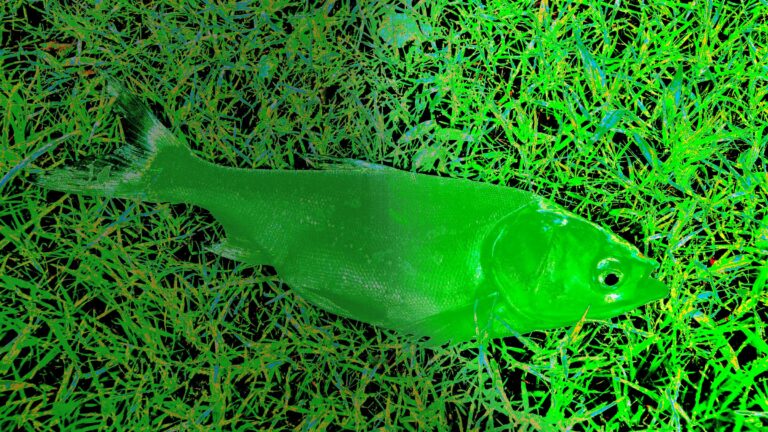Deep sea fish have diverse species such as anglerfish and lanternfish, known for their unique adaptations. Deep sea fish are fascinating creatures that inhabit the depths of the ocean, where sunlight does not penetrate.
These fish have evolved unique adaptations to survive in extreme conditions, such as inky-black darkness, immense pressure, and freezing temperatures. Some common types of deep sea fish include the anglerfish, which is known for its bioluminescent lure used to attract prey, and the lanternfish, which has special light-producing organs called photophores.
These fish demonstrate the incredible diversity of life that exists in the deep sea and provide valuable insights into the complex ecosystems that exist at great depths below the surface of the ocean.

Credit: www.nytimes.com
The Wonders Of Deep Sea Ecosystems
The depths of the ocean hold a world like no other, teeming with fascinating creatures and awe-inspiring sights. Deep sea ecosystems are a testament to the resilience of life, existing in extreme conditions that challenge even the hardiest of organisms.
In this section, we will explore the wonders of deep sea ecosystems, unravel the mysteries of the abyssal zone, and delve into the unique adaptations of deep sea fish that enable their survival in these harsh environments.
Deep Sea Ecosystems: Exploring The Unseen Depths
The deep sea is a vast and mysterious realm, largely unexplored by humans. Let’s dive into the key points about deep sea ecosystems:
- The deep sea refers to the area of the ocean below 200 meters (656 feet) where sunlight cannot penetrate. This zone is also known as the aphotic zone, as it lacks the necessary light for photosynthesis to occur.
- Despite the absence of sunlight, deep sea ecosystems exhibit astonishing biodiversity. Adapted to the darkness and extreme pressure, a wide variety of organisms thrive in this environment.
- Deep sea ecosystems are characterized by the presence of hydrothermal vents, cold seeps, and whale carcasses. These unique features provide sources of energy and nutrients that support the complex food webs in these habitats.
- The exploration of deep sea ecosystems has revealed extraordinary species such as the giant tube worm, the deep sea anglerfish, and the vampire squid. These organisms have adapted to survive in the absence of light and the scarcity of food.
Unraveling The Mysteries Of The Abyssal Zone
The abyssal zone is a deeper section of the ocean, extending from 4,000 meters (13,123 feet) to around 6,000 meters (19,685 feet) below the surface. Here are some key points about this mysterious zone:
- The abyssal zone is characterized by extreme conditions, including near-freezing temperatures, high pressures, and an absence of sunlight. These harsh conditions pose considerable challenges for life to thrive.
- Despite the challenging environment, the abyssal zone is home to a variety of unique organisms. Deep sea fish such as the blobfish and the barreleye fish have adapted to survive in the depths, with specialized features such as large mouths and bioluminescent organs.
- Ongoing scientific expeditions and advancements in technology have shed light on the abyssal zone, revealing its incredible biodiversity and ecological importance. These discoveries continue to unravel the mysteries of this deep sea realm.
- Understanding the abyssal zone is crucial for preserving and conserving the delicate balance of ecosystems in these remote parts of the ocean. By unraveling its mysteries, we can gain insights into the interconnectedness of life beneath the waves.
Unique Adaptations Of Deep Sea Fish: Survival In Extreme Conditions
Deep sea fish have evolved remarkable adaptations that enable their survival in the extreme conditions of the deep ocean. Let’s explore the key points about their unique adaptations:
- Bioluminescence: Many deep sea fish possess the ability to produce light, either through specialized organs or the presence of symbiotic bacteria. This adaptation helps them communicate, find food, and attract mates in the darkness of the deep sea.
- Gigantism: Some deep sea fish exhibit unusual size proportions, growing to enormous lengths compared to their shallow-water counterparts. This gigantism is believed to be an adaptation to the scarcity of food and the gradual metabolism of their deep-sea environment.
- Pressure resistance: Deep sea fish have adapted to withstand the tremendous pressures found in the abyssal zone. They possess specialized anatomical structures that protect their internal organs from being crushed by the weight of the water above.
- Sensory enhancements: To navigate the darkness of the deep sea, many deep sea fish have evolved enhanced sensory organs. They often have large eyes and highly sensitive lateral line systems, enabling them to detect movement and vibrations in the water.
Deep sea ecosystems are captivating and filled with wonders that continue to astonish scientists and nature enthusiasts alike. By exploring the unseen depths, unraveling the mysteries of the abyssal zone, and understanding the unique adaptations of deep sea fish, we can gain a deeper appreciation for the resilience and diversity of life in these extreme environments.
Awe-Inspiring Species In The Deep Sea
Stunning Beauty Of Anglerfish: Nature’S Living Lanterns
The deep sea is home to some truly awe-inspiring species, and one creature that immediately captivates the imagination is the anglerfish. These fascinating creatures possess a stunning beauty that is simply mesmerizing. Here are some key points to help you understand the remarkable nature of anglerfish:
- Bioluminescent allure: One of the most remarkable features of the anglerfish is its ability to emit light. This unique adaptation serves as a built-in lure, dangling from the fish’s forehead like a glowing lantern. It attracts unsuspecting prey towards its terrifyingly sharp teeth.
- Males and females: Anglerfish exhibit an unusual reproductive strategy. The females are significantly larger than the males, with the latter being dwarfed in comparison. In some species, the male actually becomes a parasite, attaching himself to the female and fusing their nervous systems together.
- Extreme habitat: Anglerfish primarily dwell in the depths of the ocean, often at depths exceeding 1,000 meters. This environment is incredibly inhospitable, with intense pressure, freezing temperatures, and scarce resources. The anglerfish has evolved to thrive in such extreme conditions.
Regal And Vibrant: The Incredible World Of Lionfish
Another magnificent deep-sea dweller is the lionfish. With their vibrant colors and extravagant fins, these creatures are as regal as their name suggests. Here are some key points to appreciate the incredible world of lionfish:
- Invasive species: Although they are native to the indo-pacific region, lionfish have become an invasive species in the atlantic ocean. Their introduction has had detrimental effects on local ecosystems, as they outcompete native species and wreak havoc on coral reefs.
- Venomous spines: Lionfish possess venomous spines on their dorsal, pelvic, and anal fins. These spines are used for self-defense and can deliver painful stings to potential predators or unsuspecting humans who come into contact with them.
- Hunting prowess: Lionfish are highly skilled hunters. They have a voracious appetite and possess an astonishing rate of consumption. With their large mouths and expandable stomachs, they are capable of swallowing prey that is over half their body size. This insatiable appetite further contributes to their invasive nature.
The Elusive Wonder: Discovering The Hatchetfish
Among the lesser-known but equally fascinating deep-sea species is the hatchetfish. These elusive creatures have adapted unique characteristics to survive in the depths. Here are some key points to discover the wonder of hatchetfish:
- Bioluminescent adaptation: Hatchetfish possess specialized light-emitting cells on their undersides, enabling them to emit a soft glow. This bioluminescence allows them to blend into the ambient light of the deep-sea environment, effectively becoming invisible to potential predators below.
- Delicate frames: Hatchetfish have a distinct body shape that resembles a hatchet, with an elongated and slender form. Their slim bodies allow them to maneuver through the water with ease and agility.
- Vertical migrators: These species undertake vertical migrations, swimming up to the near-surface waters at night in search of prey. As day breaks, they return to the darker depths to avoid predation themselves. This behavior allows them to maximize their feeding opportunities while minimizing the risk of becoming a meal.
With their captivating features and incredible adaptations, anglerfish, lionfish, and hatchetfish represent just a few of the stunning and awe-inspiring species that call the deep sea their home. Exploring the depths and uncovering the wonders of these fascinating creatures continues to amaze researchers and bring the astonishing beauty of the ocean to light.
Conservation Challenges And Efforts
Deep sea fish are fascinating creatures that inhabit the darkest depths of the ocean. These elusive creatures face numerous conservation challenges due to overfishing and habitat destruction. To protect these vulnerable species and their delicate ecosystem, sustainable fishing practices and conservation initiatives are essential.
Let’s explore further the threats to deep sea fish populations and the efforts being made to ensure their survival.
Threats To Deep Sea Fish Populations: Overfishing And Habitat Destruction
- Overfishing poses a significant threat to deep sea fish populations as many of these species have slow growth rates and low reproductive rates. The demand for their meat, highly valued in some markets, has led to unregulated and unsustainable fishing practices.
- Deep sea fish are often caught unintentionally as bycatch in commercial fishing operations targeting other species. This indiscriminate fishing method results in the accidental capture and subsequent death of these deep sea creatures.
- Habitat destruction is another major concern for deep sea fish. Bottom trawling, a method used to catch fish near the ocean floor, involves dragging heavy nets across the seabed. This destructive practice not only damages the delicate structures and ecosystems on the ocean floor but also disrupts the habitats of deep sea fish.
- The impact of climate change on deep sea fish populations cannot be overlooked. Rising ocean temperatures, ocean acidification, and changing currents can disrupt the delicate balance of their ecosystem. These changes may affect the availability of food and breeding grounds, threatening the survival of various deep sea fish species.
Maintaining A Delicate Balance: Sustainable Fishing Practices
- Implementing sustainable fishing practices is crucial to maintaining the delicate balance of deep sea fish populations. These practices aim to ensure the long-term viability of fish stocks while minimizing the impact on the ecosystem.
- Regulating fishing activities through policies and regulations helps prevent overfishing and reduces the unintended capture of deep sea fish as bycatch.
- Encouraging the use of selective fishing gear and modified fishing techniques can help minimize damage to deep sea habitats and reduce bycatch.
- Implementing seasonal fishing closures and protected areas can provide a reprieve for deep sea fish during crucial spawning and breeding periods, allowing for population recovery and sustainable fishing practices.
- Promoting ecosystem-based management approaches ensures that the entire deep sea ecosystem is taken into account when making fishing decisions. This holistic approach considers the interconnectedness of different species and their habitats, helping to maintain the delicate balance of the ecosystem.
Conservation Initiatives: Protecting The Vulnerable Deep Sea Ecosystem
- Collaborative efforts from governments, conservation organizations, and the fishing industry are essential to protect the vulnerable deep sea ecosystem.
- Research and monitoring programs play a crucial role in understanding the biology, ecology, and population dynamics of deep sea fish. This knowledge helps inform conservation measures and management strategies.
- The establishment of marine protected areas specifically focused on conserving deep sea habitats and species can provide refuge for deep sea fish, allowing populations to recover and thrive.
- Increasing public awareness about the importance of deep sea fish conservation is key to garnering support and fostering a sense of responsibility towards the protection of these unique and valuable creatures.
- International cooperation is vital in addressing the conservation challenges of deep sea fish, as many of these species span across multiple countries’ jurisdictions. Collaborative agreements and commitments can ensure coordinated efforts to protect these species and their habitats.
By addressing the threats to deep sea fish populations through sustainable fishing practices and conservation initiatives, we can help safeguard these incredible creatures and preserve the delicate balance of their deep sea ecosystem for generations to come. Together, let’s make a difference and ensure the continued existence of these mysterious and awe-inspiring deep sea fish.
Conclusion
Deep sea fish are some of the most fascinating creatures on our planet, thriving in the dark and mysterious depths of the ocean. From the eerie anglerfish to the mesmerizing viperfish, these unique species have adapted to survive in extreme conditions.
The anglerfish lures prey with its bioluminescent appendage, while the viperfish uses its long, intimidating teeth to snatch its next meal. The glowing lanternfish and the curious gulper eel showcase the incredible diversity of deep-sea fish, each with its own set of characteristics and adaptations.
These elusive creatures not only provide valuable insights into the wonders of our oceans but also serve as indicators of the health of marine ecosystems. Through ongoing research and conservation efforts, we can continue to learn about and protect these extraordinary organisms.
Explore the depths and unlock the secrets of the deep sea, where countless more extraordinary creatures may still be waiting to be discovered.






